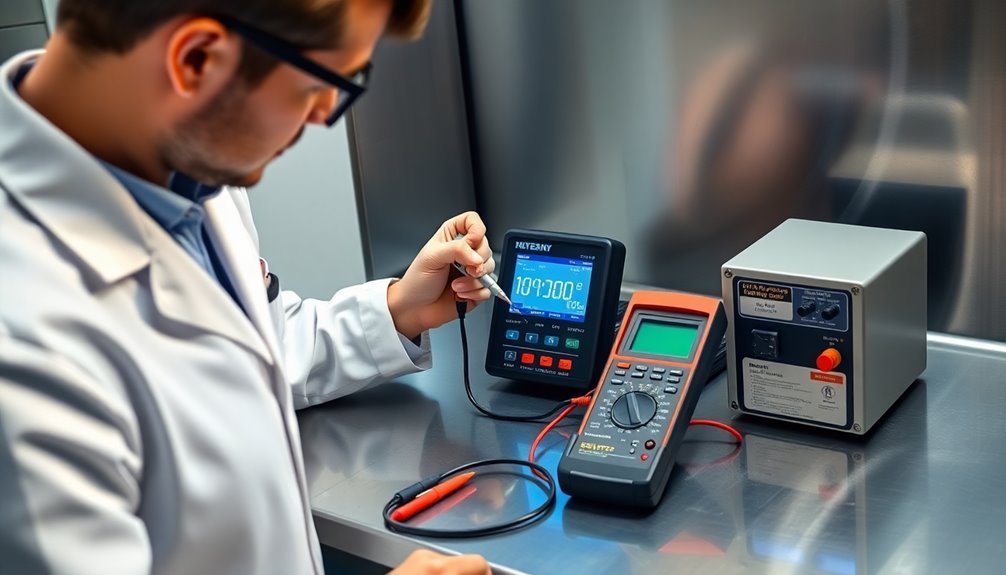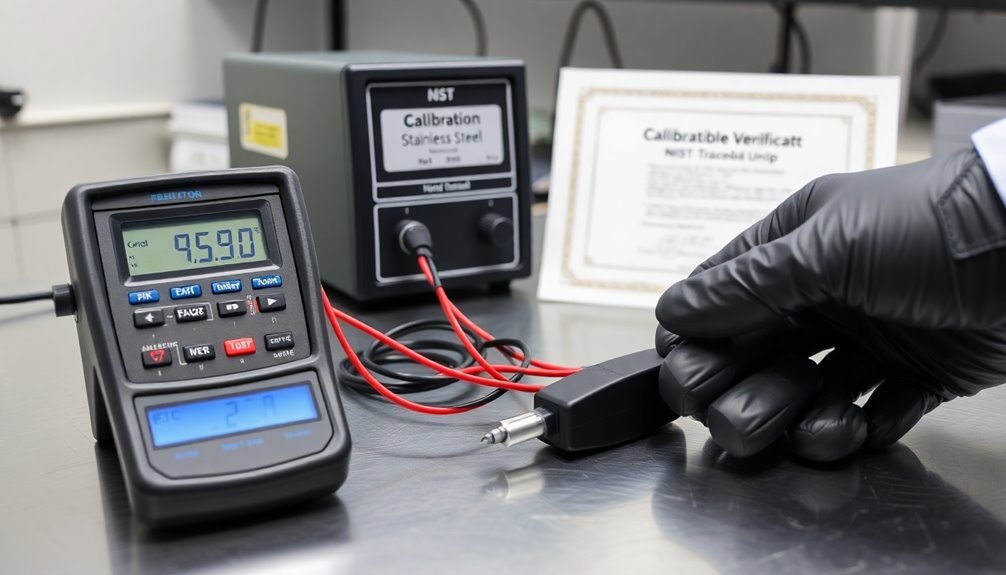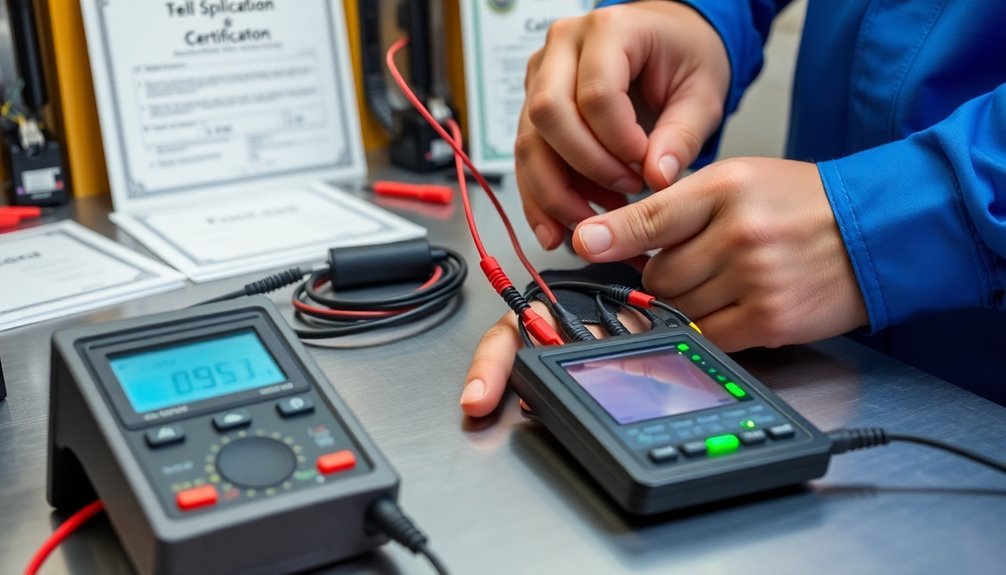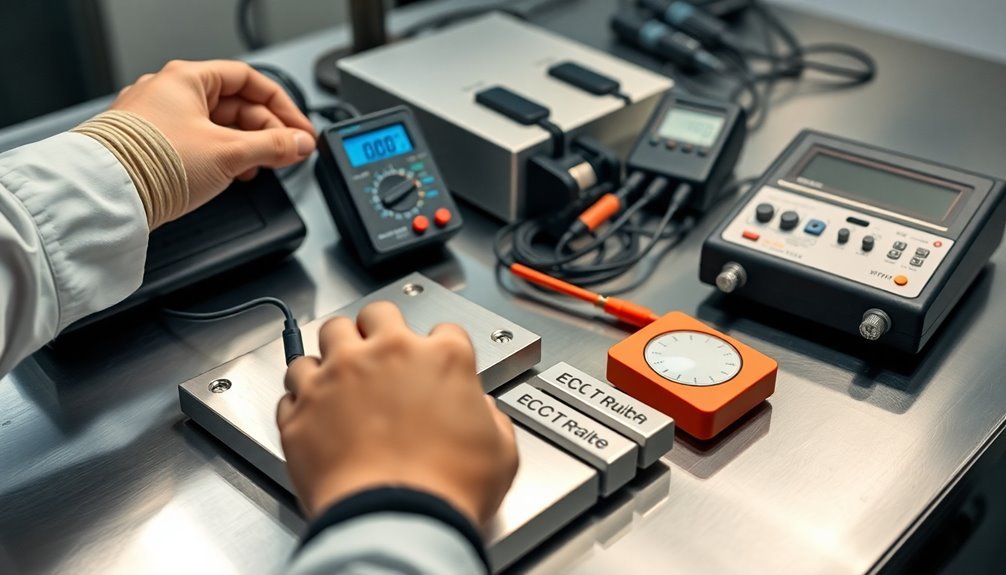ESD monitor calibration testing services will guarantee your static control equipment stays accurate and compliant with key standards like IEC 61000-4-2 and ANSI/ESD S20.20. You'll receive thorough testing of voltage levels, resistance measurements, and temperature/humidity sensor verification. Professional calibration providers conduct systematic assessments using specialized equipment, perform necessary adjustments, and document all results with NIST traceability. They'll also verify your equipment's performance across multiple parameters and establish regular maintenance schedules. Whether you need on-site or laboratory calibration, understanding the full scope of these essential services can help protect your sensitive electronics and maintain quality control.
ESD Calibration Equipment Requirements

When performing ESD monitor calibration, you'll need specific equipment that meets stringent international standards. Your ESD simulators must comply with IEC 61000-4-2 and ISO 10605 standards, maintaining voltage tolerances of ± 15 kV and ± 25 kV respectively, with accuracy better than ± 5%.
You'll require high-impedance meters like the ES105-100 and non-contact electrometers such as the ES102 for accurate measurements. Your high voltage meters must have an input impedance exceeding 100 G Ohm to prevent discharging the ESD simulator tip during testing.
For target calibration, you'll need to mount your ESD current target on a 60" x 60" vertical calibration plane or larger. The target must be secured with 8 screws and lock-washers for proper grounding and stability. You must use well-shielded, low-loss cables like RG400 or RG214, keeping them under 1 meter in length.
Don't forget to calibrate your entire ESD target-attenuator-cable chain, including the oscilloscope. Your oscilloscope must have sufficient input voltage rating and bandwidth to handle ESD currents accurately.
You'll also need certified calibration equipment, such as the CST1 ESD Current Target Calibration Kit, to guarantee measurements meet required specifications and standards.
Types of Monitor Testing Services
With your calibration equipment properly set up, you'll need to select the right testing services for your ESD monitoring needs.
You'll find several essential calibration services available, including voltage calibration to verify accurate measurement levels, resistance calibration for testing equipment, and temperature and humidity sensor calibration for your testing environment.
You'll also need ESD simulator calibration for your discharge testing equipment and static decay analyzer calibration to measure dissipation rates.
These services typically include thorough testing procedures.
You'll start with proper setup and configuration of your device under testing, followed by controlled ESD events using calibrated simulators.
During testing, you'll monitor device performance and test your ESD protection equipment, including wrist straps, mats, and gloves.
You can choose from different calibration levels, including on-site Level 1 and Level 2 services, or ISO 17025 accredited laboratory calibration.
Expert analysis services are provided for material development and qualification.
You'll get access to asset management tools for tracking certificates and invoices.
Regular calibration isn't just about maintaining accuracy – it's essential for standards compliance, preventing device damage, and correcting sensor drift over time.
Remember to follow manufacturer recommendations for calibration frequency to guarantee reliable results.
Standards and Compliance Guidelines

Your ESD monitor calibration services must align with ISO certification requirements, which mandate regular testing and documentation of all calibration procedures.
Annual testing requires proper ground verification to ensure adherence to safety standards and equipment functionality.
You'll need to follow specific testing protocols that meet ANSI/ESD S20.20 standards, ensuring your monitoring equipment maintains accuracy within acceptable parameters.
Documentation of your calibration results should include traceability to NIST standards and detailed records of testing dates, methods, and outcomes.
ISO Certification Requirements
Several critical ISO certification requirements govern ESD monitor calibration and testing services. You'll need to verify your facility meets ISO 9001:2015 standards, which establish the framework for your quality management system. This certification proves you've implemented proper screening processes and management principles for continuous improvement in your ESD monitoring operations.
To achieve ISO certification, you'll need to undergo thorough third-party audits conducted by accredited certification bodies. Your facility must demonstrate a professional system that effectively reduces static electricity during production processes. You'll also need to show evidence of proper process screening methods and quality control measures specific to ESD monitoring equipment. Working with certified suppliers helps ensure compliance with stringent quality standards throughout the supply chain.
The certification requirements emphasize technical competence, particularly under ISO/IEC 17025:2017 standards for testing and calibration laboratories. You'll need to maintain detailed documentation of your calibration procedures, verify NIST traceability for all measurements, and implement extensive tracking systems like Fluke MET/TEAM for asset management.
Your quality management system must also include regular assessment protocols, staff training programs, and continuous monitoring of your ESD control measures to maintain certification compliance.
Testing Protocol Standards
Thorough testing protocol standards establish specific requirements for ESD monitor calibration services.
Standards help provide consistent evaluation methods for comparing and validating ESD control solutions.
You'll need to follow strict procedures that comply with ANSI/ESD SP5.3.3 and ISO/IEC 17025:2005(E) standards to guarantee accurate calibration results.
Your calibration process must include extensive grounding checks before testing begins.
You're required to use specific meter settings, such as the "10 Volt Test" position for surface-to-ground measurements, and test a minimum of five locations from the mat to the ground.
The pass/fail criteria you'll follow includes specific resistance ranges between 1 x 10^6 and 1 x 10^10 Ohms.
You must document all test results in certification records like the ESD Station Certification Record (FRM-1145).
Annual testing and recertification are mandatory, with additional calibration needed after any equipment changes.
You'll need to maintain quality control measures that align with DoD/DOE Quality Systems Manual requirements and guarantee your personnel are properly trained in calibration procedures.
When you're using specific equipment, such as ESD Systems.com brand monitors, you must follow manufacturer-specific guidelines using designated calibration units like the item #41119.
Professional Calibration Service Procedures
Professional calibration services begin with extensive testing and assessment of your ESD monitoring equipment to establish baseline performance metrics.
Similar to gas detection equipment that requires monthly calibrations, regular testing and documentation helps ensure your ESD monitors maintain proper functionality and accuracy over time.
Your equipment then undergoes systematic calibration across voltage, resistance, temperature, and humidity parameters using ISO/IEC 17025 accredited procedures and specialized testing instruments.
The final stage involves thorough performance verification to confirm your equipment meets all required specifications and industry standards before issuing detailed calibration certificates.
Initial Testing and Assessment
Calibration service providers initiate their process by conducting thorough testing and assessment of ESD monitoring equipment.
They'll evaluate your equipment according to ISO 17025 accreditation standards, guaranteeing all measurements are traceable and reliable. During this phase, they'll perform extensive tests of voltage, resistance, temperature, and humidity parameters to verify your equipment operates within specified tolerances. The NIST traceable calibration ensures the highest level of measurement accuracy and reliability.
Your equipment will undergo manufacturer-specific testing procedures to maintain compliance with original device specifications. The assessment includes a detailed evaluation of your ESD workstation's ground connection and associated equipment.
They'll use specialized tools like verification testers and charge plate monitors to check test limits and measure ESD events accurately. You'll receive precise documentation of both incoming and outgoing equipment status, including any necessary adjustments or firmware updates.
The initial assessment also determines if your equipment needs preventive maintenance, such as cleaning or electrical safety tests.
If you're using on-site calibration services, technicians will evaluate your facility's conditions, including temperature and humidity levels, to guarantee ideal calibration results. They'll provide recommendations for any environmental adjustments needed to achieve the most accurate calibration outcomes.
Step-by-Step Calibration Process
The step-by-step ESD monitor calibration process begins with proper equipment setup and grounding procedures.
You'll need to connect your calibration box to a verified ground source and position the selector switch fully counterclockwise. Make certain you're using the appropriate adapters and banana plugs, with the ground-marked plug connected to a known ground point.
For operator circuit calibration, you'll test through a sequence of positions. Start by rotating the selector switch to LOW LIMIT FAIL to verify the red LED and alarm activation. Then, move through LOW LIMIT PASS and HIGH LIMIT PASS positions, confirming proper green LED operation. Our experienced technicians ensure precise calibration across multiple industries including aerospace and medical sectors.
Finally, test the HIGH LIMIT FAIL position to ascertain the red LED activates and green LED turns off.
Work surface calibration requires disconnecting the mat and connecting the calibration unit adapter to the monitor's mat cord. You'll need to keep the adapter isolated from the grounded mat while testing through the same limit positions.
Throughout the process, you'll document all readings and responses. Professional calibration services should provide NIST-traceable results and detailed certificates.
For peak performance, you should have this calibration performed annually, with periodic verification checks every 6-12 months using a Workstation Monitor Checker.
Final Performance Verification
Final verification marks the crucial endpoint of ESD monitor calibration, where technicians must confirm that all adjustments meet industry specifications and performance requirements. During this stage, you'll receive thorough documentation detailing the testing results and performance metrics of your ESD monitor.
Post-calibration checks guarantee your device operates within acceptable parameters and complies with standards like IEC 61000-4-2 and ANSI/ESD S20.20. Technicians will verify each function against established benchmarks and document any variations or adjustments made during the calibration process.
You'll get a detailed calibration certificate that includes your device's serial number, calibration dates, and specific test results.
The verification process also generates maintenance recommendations for your ESD monitor's peak performance. These suggestions help you plan future calibrations and preventive maintenance.
Your calibration records will include a complete testing log that supports quality assurance requirements and helps during audits. If you're managing multiple devices, you'll find these records invaluable for tracking performance trends and making informed decisions about equipment maintenance schedules.
Remember to store these documents in a secure location, as they're indispensable for demonstrating compliance with industry standards.
Equipment Performance Verification Methods

Proper ESD monitor performance verification requires systematic testing procedures using specialized calibration equipment.
You'll need to use a calibration unit that provides various resistance settings to accurately test both operator and work surface monitoring functions.
To verify your ESD monitor's performance, you'll start by selecting specific test points on the calibration unit. Connect the unit to your monitor and adjust the trim pot until you achieve the correct pass/fail results.
You should rotate the selector switch through different positions to test low limit fail, low limit pass, high limit pass, and high limit fail scenarios.
When testing wrist straps, you'll verify readings using specific resistance values (like 9M, 11M, 18M, and 22M ohms), guaranteeing the monitor alarms at the upper limit of 100 Meg ohms.
For workstation surfaces, you'll follow a similar process, connecting the calibration unit to known ground and monitor jacks.
Throughout the verification process, you'll need to make trim pot adjustments to guarantee accurate pass/fail indications.
Remember that while there aren't fixed high/low values, your focus should be on achieving reliable pass/fail results that comply with ESD standards.
Calibration Schedule and Maintenance
Regular monitoring of your ESD equipment requires a structured calibration schedule and maintenance plan.
You'll need to follow annual calibration recommendations for Full-Time Continuous Monitors while performing verification checks every 6-12 months using specialized equipment like the Desco 98221 Wave Distortion Monitor Verification Tester.
Your calibration frequency should align with the critical nature of your ESD-sensitive items and industry standards.
You'll want to maintain detailed records of all calibration results and adjustments, verifying they're traceable to NIST standards through equipment like the Desco EMIT 50512 Continuous Monitor Calibration Unit.
To maintain peak performance, you must account for sensor drift and environmental conditions that can affect your equipment's accuracy.
You'll need trained personnel who understand the difference between bump testing and full calibration procedures.
Establish internal calibration capabilities if possible, as this enables more frequent testing when needed.
Don't forget to conduct pre and post-calibration checks to guarantee reliable ESD testing operations.
Regular maintenance, combined with proper documentation and periodic procedure reviews, will help you maintain compliance with industry standards while protecting your sensitive components.
Common ESD Monitor Testing Issues

Testing ESD monitors presents several vital challenges you'll need to address. When performing ESD monitor calibration, you'll encounter issues with simulator inconsistencies that can lead to varying test results between different devices.
You'll need to watch for unwanted oscilloscope triggers that can skew your measurements and recognize when EMI interference affects your vertical amplifier readings.
Cable-related problems often create significant testing complications. You'll need to guarantee proper cable termination and implement adequate shielding to prevent ESD-induced currents from corrupting your test data.
Pay special attention to system-level challenges, as these tests involve more severe currents and faster rise times that can trigger latch-up events in operating systems.
Your testing environment must account for ground bus voltage drops and high-frequency components that can radiate into enclosures.
Don't overlook maintenance-related issues – regular inspection of your testing equipment is essential. You'll need to verify that all ESD control products remain compliant and functional, especially ionizers that require proper balance adjustments.
Remember that incorrect grounding of test equipment can compromise your entire testing process and lead to unreliable results.
Choosing Reliable Calibration Providers
A reliable calibration provider forms the cornerstone of your ESD monitoring program's success. When selecting a provider, you'll need to evaluate their technical expertise, service network, and support capabilities to guarantee they meet your specific requirements.
| Key Feature | Why It Matters |
|---|---|
| National Coverage | Ensures quick service access and consistent support across locations |
| Quality Programs | Guarantees accurate, reliable calibration results meeting industry standards |
| Technical Expertise | Provides specialized knowledge for various instrument types and industries |
| Delivery Options | Offers flexibility with onsite service, pickup, or service center options |
| Asset Management | Enables efficient tracking and maintenance scheduling of your equipment |
You'll want to choose a provider that offers NIST-traceable calibration services and employs experienced technicians familiar with aerospace, automotive, and medical industries. They should demonstrate expertise in multi-brand calibration and provide various calibration levels to match your quality requirements. Look for providers offering thorough support, including repair services and quick turnaround times for urgent needs. Their pricing should be transparent, and they should maintain quality control measures throughout their service delivery process.
Frequently Asked Questions
How Long Does a Typical ESD Monitor Calibration Service Take to Complete?
You'll find most ESD monitor calibrations take 2-5 business days for standard service, though this can vary. You can opt for rush services if you're in a hurry or schedule on-site calibration.
Can ESD Monitors Be Calibrated While Still Installed in Production Areas?
Yes, you can have your ESD monitors calibrated while they remain installed in production areas. This on-site calibration minimizes downtime and guarantees your equipment stays in place during the testing process.
What Happens if Calibration Results Show Equipment Is Out of Specification?
You'll need to immediately quarantine the out-of-spec equipment, reevaluate any products inspected with it, document findings, and implement corrective actions. Then, recalibrate the equipment before returning it to service.
Are Loaner ESD Monitors Available During Calibration Service Periods?
Yes, you'll find that many calibration services offer loaner ESD monitors during service periods. You can request them to maintain continuous operations at your site while your equipment undergoes calibration.
Do Calibration Services Include Firmware Updates for Digital ESD Monitors?
No, calibration services don't include firmware updates for your digital ESD monitors. You'll need to handle firmware updates separately, following manufacturer instructions, as they're distinct from calibration and require different technical expertise.
In Summary
You'll need regular ESD monitor calibration to maintain accurate protection of your sensitive electronic components. By working with qualified calibration providers and following recommended testing schedules, you're ensuring your monitoring equipment meets industry standards and performs reliably. Don't forget to keep detailed calibration records and address any performance issues promptly to maintain your ESD control program's effectiveness.





Leave a Reply